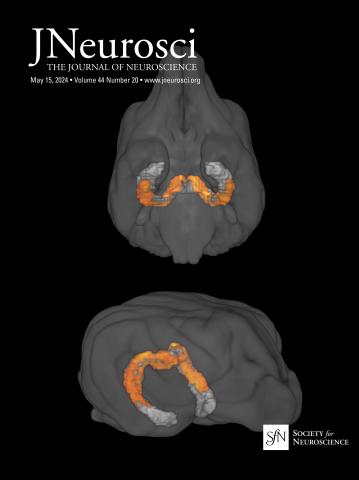Developmental Syngap1 haploinsufficiency in medial ganglionic eminence-derived interneurons impairs auditory cortex activity, social behavior and extinction of fear memory.
IF 4.4
2区 医学
Q1 NEUROSCIENCES
引用次数: 0
Abstract
Mutations in SYNGAP1, a protein enriched at glutamatergic synapses, cause intellectual disability associated with epilepsy, autism spectrum disorder and sensory dysfunctions. Several studies showed that Syngap1 regulates the time course of forebrain glutamatergic synapse maturation; however, the developmental role of Syngap1 in inhibitory GABAergic neurons is less clear. GABAergic neurons can be classified into different subtypes based on their morphology, connectivity and physiological properties. Whether Syngap1 expression specifically in Parvalbumin (PV) and Somatostatin (SST)-expressing interneurons, which are derived from the medial ganglionic eminence, plays a role in the emergence of distinct brain functions remains largely unknown. We used genetic strategies to generate Syngap1 haploinsufficiency in a) prenatal interneurons derived from the medial ganglionic eminence, b) in postnatal PV cells and c) in prenatal SST interneurons. We further performed in vivo recordings and behavioral assays to test whether and how these different genetic manipulations alter brain function and behavior in mice of either sex.Mice with prenatal-onset Syngap1 haploinsufficiency restricted to Nkx2.1-expressing neurons show abnormal cortical oscillations and increased entrainment induced by 40Hz auditory stimulation, but lack of stimulus-specific adaptation. This latter phenotype was reproduced in mice with Syngap1 haploinsufficiency restricted to PV, but not SST, interneurons. Prenatal-onset Syngap1 haploinsufficiency in Nkx2.1-expressing neurons led to impaired social behavior and inability to extinguish fear memories; however, neither postnatal PV- nor prenatal SST-specific mutant mice show these phenotypes. We speculate that Syngap1 haploinsufficiency in prenatal/perinatal PV interneurons may contribute to cortical activity and cognitive alterations associated with Syngap1 mutations.Significance statement Mutations in the human gene cause a form of developmental epileptic encephalopathy associated with intellectual disability, autism and sensory dysfunctions. Several studies have shown that in addition to playing a major role in the synaptic maturation and plasticity of forebrain excitatory neurons, Syngap1 affects GABAergic circuit function as well. Forebrain GABAergic neurons can be divided into different subtypes. Whether Syngap1 expression specifically in distinct interneuron populations and during specific developmental time windows plays a role in the emergence of distinct brain functions remains largely unknown. Here, we report that early, pre or perinatal Syngap1 expression in developing GABAergic neurons derived from the medial ganglionic eminence promotes the development of auditory cortex function, social behavior and ability to extinguish fear memories.内侧神经节突触派生的中间神经元的发育性Syngap1单倍体缺陷会损害听觉皮层的活动、社交行为和恐惧记忆的消退。
SYNGAP1是一种富含于谷氨酸能突触的蛋白质,它的突变会导致与癫痫相关的智力残疾、自闭症谱系障碍和感觉功能障碍。多项研究表明,SYNGAP1 可调节前脑谷氨酸能突触成熟的时间进程;然而,SYNGAP1 在抑制性 GABA 能神经元中的发育作用却不太清楚。GABA 能神经元可根据其形态、连接性和生理特性分为不同的亚型。Syngap1是否特异性地表达于表达副神经元(PV)和体生长抑素(SST)的中间神经元(这些神经元来自内侧神经节突起),从而在不同大脑功能的出现中发挥作用,这一点在很大程度上仍不清楚。我们采用遗传学策略,在 a) 来源于内侧神经节突起的产前中间神经元、b) 产后 PV 细胞和 c) 产前 SST 中间神经元中产生了 Syngap1 单倍体缺陷。我们进一步进行了体内记录和行为测定,以检验这些不同的遗传操作是否以及如何改变小鼠的大脑功能和行为。限制在 Nkx2.1 表达神经元中的产前发生的 Syngap1 单倍缺失小鼠表现出异常的皮层振荡和由 40Hz 听觉刺激引起的夹带增加,但缺乏刺激特异性适应。后一种表型在Syngap1单倍体缺陷仅限于PV而非SST中间神经元的小鼠中重现。产前Nkx2.1表达神经元的Syngap1单倍体缺陷导致社交行为受损和无法熄灭恐惧记忆;然而,产后PV和产前SST特异性突变小鼠均未表现出这些表型。我们推测,产前/围产期PV中间神经元中的Syngap1单倍体缺陷可能会导致与Syngap1突变相关的皮层活动和认知改变。多项研究表明,Syngap1 除了在前脑兴奋性神经元的突触成熟和可塑性方面发挥重要作用外,还影响 GABA 能回路的功能。前脑GABA能神经元可分为不同的亚型。Syngap1是否特异性地在不同的中间神经元群和特定的发育时间窗中表达,在不同大脑功能的出现过程中发挥作用,目前仍是一个未知数。在这里,我们报告了来自内侧神经节突起的GABA能神经元在发育早期、出生前或围产期的Syngap1表达促进了听觉皮层功能、社会行为和熄灭恐惧记忆能力的发育。
本文章由计算机程序翻译,如有差异,请以英文原文为准。
求助全文
约1分钟内获得全文
求助全文
来源期刊

Journal of Neuroscience
医学-神经科学
CiteScore
9.30
自引率
3.80%
发文量
1164
审稿时长
12 months
期刊介绍:
JNeurosci (ISSN 0270-6474) is an official journal of the Society for Neuroscience. It is published weekly by the Society, fifty weeks a year, one volume a year. JNeurosci publishes papers on a broad range of topics of general interest to those working on the nervous system. Authors now have an Open Choice option for their published articles
 求助内容:
求助内容: 应助结果提醒方式:
应助结果提醒方式:


